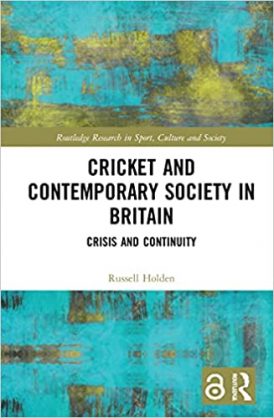Cricket and Contemporary Society in Britain: Crisis and Continuity
Martin Chandler |Published: 2021
Pages: 171
Author: Holden, Russell
Publisher: Routledge
Rating: 4 stars

Over the years I’ve taken to reading a book’s bibliography before starting on the narrative itself. As the decades passed and my collection grew I found myself feeling increasingly smug as I went through long lists of books and found that I already owned many of them.
And then I had something of a ‘light bulb’ moment, and realised that wasn’t actually a good thing. After all if a writer has not found any sources beyond those I am already aware of I am not going learn anything new, however skilled a wordsmith he might be.
The bibliography in Cricket and Contemporary Society in Britain: Crisis and Continuity consists, give or take, of 163 items. Admittedly a goodly number are articles, papers or journal pieces as opposed to mainstream publications, but the fact that I could only claim familiarity with 20 of them was a clear indication that I had a great deal to learn from Holden’s words, particularly as those research materials are backed up by interviews with no less than 26 individuals, all of whom are important and worth name checking although, for the sake of brevity, I will mention just a single name, that of Azeem Rafiq.
The book is a history book, but although one of ‘the 20’ is the Nyren’s classic 1833 text The Cricketers of my Times, Holden’s study starts just before the turn of the millennium, meaning that everyone who reads it has lived through what it looks at, and will have their own opinions on the issues it examines.
Holden therefore begins his work with a chapter on how English cricket reached its nadir of 1999, before then looking at the glorious redemption of that wonderful Ashes summer of 2005. From there Holden looks at cricket as a ‘British’, as opposed to ‘English’, game before visiting the decline of the game in the Afro-Caribbean community and, if I may put it this way, the rise of it in the South Asian community without, sadly, that rise being reflected in the opportunities becoming available.
After tackling those subjects it is the turn of the game’s shortest format, followed by a comparison between the English experience and how the game’s other major centres have dealt with the last couple of decades. The book then winds down with a look at that other major development, the increase in interest in women’s cricket, followed by a few concluding remarks and a look at how the pandemic has and continues to influence the game.
One development that came just after the book was published was the furore that surrounded the revelations from Rafiq that so publicly shamed the game a few weeks ago. That there was a problem with institutional racism in English cricket was something that I had been blissfully ignorant of prior to the revelations of late last year, and I did not fully understand them until I read Duncan Stone’s book, Different Class.
As soon as I knew that Rafiq was one of the interviewees for Holden’s research I realised that it was highly unlikely the news appearing at the time it did, a few weeks after publication, would cause any sort of issue, and having now read the book I am sure it didn’t. The truth is that the reality of the situation was clear for all to see long before the story broke, but despite that most of us, Holden and Stone being honourable exceptions, didn’t bother to open our eyes.
After reading Cricket and Contemporary Society in Britain: Crisis and Continuity it is, in some ways, slightly embarrassing to look back and think about some of the opinions I have espoused in the recent past. This is not because I now think those views were wrong, and indeed most of them I still hold, but the difference is that I now understand fully what the issues are rather than just seizing on a single aspect.
Many of the subjects Holden studies have been carefully explored by others, and empirical research has been carried out and analysed. I know now what that concluded and, importantly, appreciate the importance of those, shall we say inconvenient, truths that I have always been happy to skirt around in the past (if they even occurred to me).
Such a comprehensive overview and, consequently, a sound environment in which a reader can make his or her own judgments is, I suppose, part of the purpose of what is essentially an academic text. On the face of matters it seems odd therefore, but perhaps in reality is inevitable, that that very strength of Cricket and Contemporary Society in Britain: Crisis and Continuity is also its weakness.
The book is not a showy one by any means. That of itself is not the problem, as the initially unprepossessing boards are in fact very nicely designed. But the absence of any illustrations or an expensive feel to the book are factors that are not going to make the price tag of £120 an attractive one, and even the cost of the ebook version, which currently comes in at just over a quarter of that price will deter many, which is a little unfortunate as this is a book that deserves to be read well beyond the world of academia.







Leave a comment